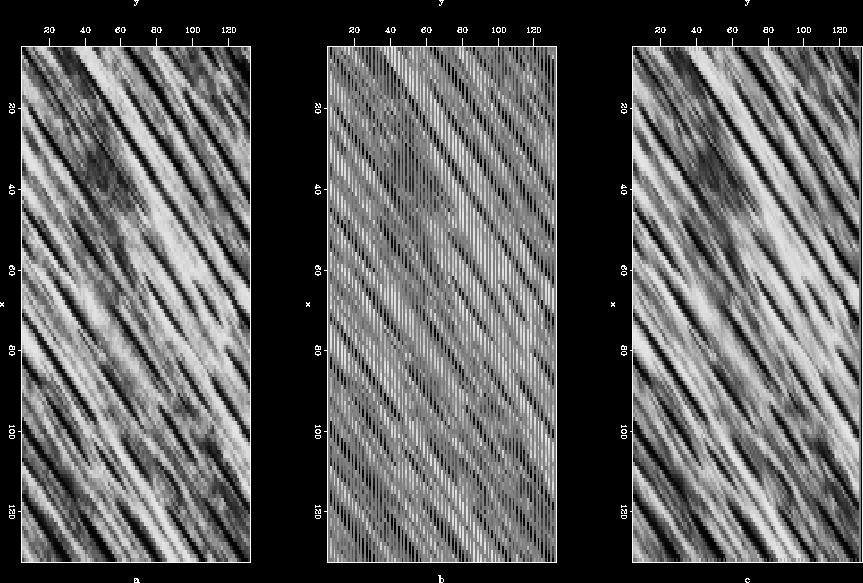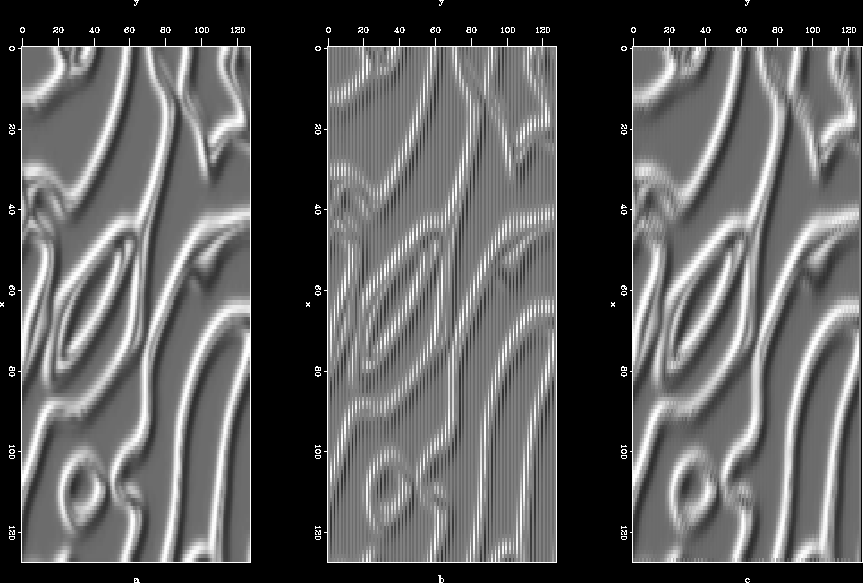




Next: Missing Chunks of data
Up: 2D Test Cases
Previous: 2D Test Cases
The problem of alternate missing columns (without aliasing) is one of the ideal cases to work on, especially, with this method. Interpolation using this approach involves two steps, first to estimate the filter using inversion, and second to estimate the missing data. The second step is not an inversion, unlike PEFs. Even though this has a computational advantage, it is not appropriate for real data sets, which might need some kind of model styling.
At first, I use the wood texture (Figure ![[*]](http://sepwww.stanford.edu/latex2html/cross_ref_motif.gif) (a)) as a test case. In terms of statistics, this image is relatively stationary. I replace alternate columns with zero traces to create Figure
(a)) as a test case. In terms of statistics, this image is relatively stationary. I replace alternate columns with zero traces to create Figure ![[*]](http://sepwww.stanford.edu/latex2html/cross_ref_motif.gif) (b) and then use the covariance-based filters to fill in the gaps. The reconstructed image is given in Figure
(b) and then use the covariance-based filters to fill in the gaps. The reconstructed image is given in Figure ![[*]](http://sepwww.stanford.edu/latex2html/cross_ref_motif.gif) (c). Results look good, primarily because we are very close to our approximation of local stationarity.
(c). Results look good, primarily because we are very close to our approximation of local stationarity.
woodf
Figure 2 (a) Wood texture, (b) wood texture with alternate columns missing, and (c) reconstructed wood texture.
Another test case that I demonstrate here is the texture made up of ridges (Figure ![[*]](http://sepwww.stanford.edu/latex2html/cross_ref_motif.gif) (a)) . This to some extent violates the assumption of stationarity because of the presence of multiple and conflicting dips. Figures
(a)) . This to some extent violates the assumption of stationarity because of the presence of multiple and conflicting dips. Figures ![[*]](http://sepwww.stanford.edu/latex2html/cross_ref_motif.gif) (b) and
(b) and ![[*]](http://sepwww.stanford.edu/latex2html/cross_ref_motif.gif) (c) illustrate the images with missing and reconstructed data respectively. As can be observed, results are good but not perfect.
(c) illustrate the images with missing and reconstructed data respectively. As can be observed, results are good but not perfect.
ridgesf
Figure 3 (a) Ridge texture, (b) ridge texture with alternate columns missing, and (c) reconstructed ridges texture.





Next: Missing Chunks of data
Up: 2D Test Cases
Previous: 2D Test Cases
Stanford Exploration Project
1/16/2007
![[*]](http://sepwww.stanford.edu/latex2html/cross_ref_motif.gif) (a)) as a test case. In terms of statistics, this image is relatively stationary. I replace alternate columns with zero traces to create Figure
(a)) as a test case. In terms of statistics, this image is relatively stationary. I replace alternate columns with zero traces to create Figure ![[*]](http://sepwww.stanford.edu/latex2html/cross_ref_motif.gif) (b) and then use the covariance-based filters to fill in the gaps. The reconstructed image is given in Figure
(b) and then use the covariance-based filters to fill in the gaps. The reconstructed image is given in Figure ![[*]](http://sepwww.stanford.edu/latex2html/cross_ref_motif.gif) (c). Results look good, primarily because we are very close to our approximation of local stationarity.
(c). Results look good, primarily because we are very close to our approximation of local stationarity.

